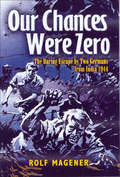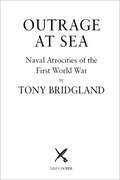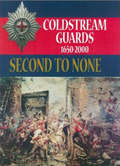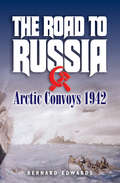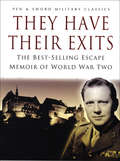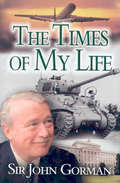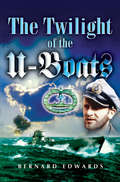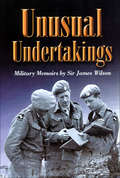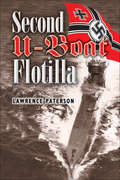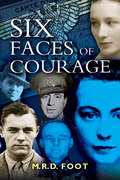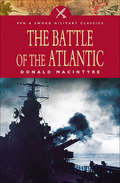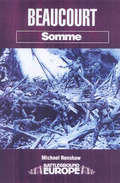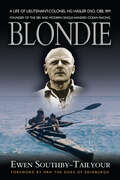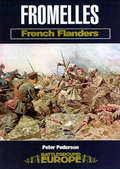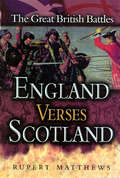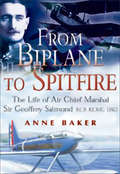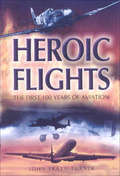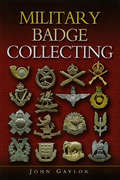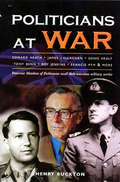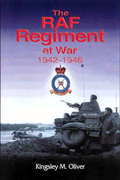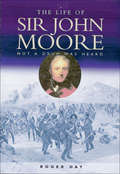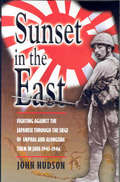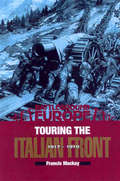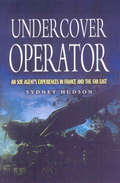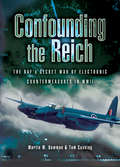- Table View
- List View
Our Chances were Zero: The Daring Escape by two German POW's from India in 1942
by Rolf MagenerDuring World War II the British imprisoned many German and Italian prisoners of war and civilian internees in India. The less co-operative prisoners were kept under harsh conditions in camps in the Himalayan foothills. The author was a German civilian working in India at the outbreak of war and was promptly interned by the British. In 1942 Magener and another prisoner, Heins von Have, finally managed to escape. Getting out of the camp was only the prelude to the difficult task of making their way across the entire Indian sub-continent in an attempt to reach friendly territory. Disguising themselves as British officers, the two Germans made an epic journey across India and through British forces on the Burma frontier in an attempt to link up with advancing Japanese forces. Ironically, the Japanese unit they finally located did not believe their story and they came close to being executed as spies.His grippingly told personal narrative of a German's escape from Allied custody is unique in the annals of prisoner-of-war escape and evasion.
Outrage at Sea: Naval Atrocities of the First World War
by Tony BridglandThis, the follow-up to Naval Atrocities in World War 2, is an anthology of shameful incidents at sea, causing outrage on both sides. The sinking of the Lusitania was the trigger of these events, which were played out, at least initially, while an anguished and undecided America looked on. Later in the War, the Hospital Ships, carrying wounded troops home from the theatres of war, became controversial targets for U-Boats. The treatment of U-Boat crews by Allied navies was itself at times hugely controversial. At the end of it all, the world's first ever War Crimes Trials were held at Leipzig in farcical conditions.
Second to None: The History of the Coldstream Guards, 1650–2000
by Julian PagetFamiliar to tourists at Buckingham Palace, the Coldstream Guards are also a fully operational combat unit. The regiment played a key role at Blenheim and Waterloo, fought at Monmouth in the American Revolution, served in both World Wars and is frequently deployed on short notice to the world's trouble spots even today. This lavishly illustrated volume has been produced to mark the regiment's 350th anniversary. Contributors include numerous distinguished British historians and past members of the regiment. Full details are given for both the Coldstream Guards' ceremonial duties and their participation in some of the key events in European history.
The Road to Russia: Arctic Convoys, 1942–45
by Bernard EdwardsBernard Edwards, the formidable naval historian, has researched the fate of Convoys PQ13 and PQ17 bound from Iceland to Northern Russia as well as the westbound Convoy QP13. Attacked relentlessly by aircraft and U-boats, the former lost a total of thirty ships while QP13 ran into a British minefield off Iceland, losing seven vessels. The Road to Russia is an important addition to the bibliography of this bitterly fought campaign.
They Have Their Exits: The Best Selling Escape Memoir of World War Two (Pen & Sword Military Classics)
by Airey NeaveThe author of Saturday at M.I.9 and former British soldier recounts his escape from Nazi captivity during World War II in this military memoir. Wounded and captured at Calais in May 1940, Second Lieutenant Airey Neave wasted little time before attempting to escape. Always a thorn in his captors&’ sides, he earned his place in the &“escape-proof&” Colditz Castle. Undeterred, he had the distinction of being the first British officer to make a &“home run,&” via Switzerland, Vichy France, and Spain. Soon back in France working with the French Resistance as a member of M.I.9, rescuing Allied airmen, he found himself playing a leading role saving stranded survivors of 1st Airborne Division at Arnhem. Neave&’s extraordinary memoir continues even after Germany&’s surrender. Having arrested the directors of the mighty Krupp empire, he served with the Nuremburg War Crimes Tribunal where he came into personal contact with leading Nazis, gaining a unique insight into their characters and deeds. If ever there was a great and true story well told, it is They Have Their Exits. Reprinted once again it is a fitting memorial to a man of exceptional energy, initiative, and courage.Praise for They Have Their Exits&“One of the best escape memoirs to emerge from the Second World War, combining the adventure story of most with a deeper examination of the mental impact of captivity and escape, and the stresses and risks all the way along the escape routes.&” —History of War
Sir John Gorman: The Times of My Life
by John GormanThe Northern Ireland politician and British Army veteran chronicles his storied life in this memoir.After serving in the Irish Guards in northwest Europe (where he won a legendary MC for ramming a King Tiger tank), John Gorman’s career included being Head of Security with BOAC, and closely involved with Royal visits. Later he was Europe’s largest landlord running the Northern Ireland Housing Executive. before entering politics and becoming Deputy Speaker of the Northern Ireland Assembly. Sir John Gorman exudes relaxed charm, humour and impeccable style. This book mirrors all these enviable characteristics and makes for a thoroughly enjoyable and entertaining read.
Twilight of the U-Boats
by Bernard EdwardsIn essence, this is the story of U-223,commanded by Karl-Jrgen Wehter from the time of her commissioning in Kiel in January 1943 through a murderous career to her eventual but dramatic demise in the Mediterranean in March 1944. At the same time, the book covers the declining fortunes of the U-boat arm as a whole from early 1943 when it seemed invincible and seriously threatened the Allies with defeat to the end of the war.
Unusual Undertakings: Military Memoirs
by James WilsonTo find an example of a full and successful, yet unconventional, military career, one need look no further than General 'Jim' Wilson. Always an outstanding sportsman, Jim found himself in the Rifle Brigade after Oxford just before the Second World War. His memoir concentrates on six of his major military endeavors; North Africa as a platoon commander followed by the long struggle up through Italy, both with the Rifle Brigade. After the war he was sent to India and became caught up in the momentous events of Partition, and in a position to comment on all the key political and military personalities. His career prospered and he was one of the first commanders of a major peacekeeping operation in Cyprus, again closely involved with leaders such as Archbishop Makarios.
Second U-Boat Flotilla
by Lawrence PatersonFritz-Julius Lemp's tragic sinking of the Athenia in a Second U-Boat Flotilla boat opened Germany's U-boat war against England. The following six years of bitter combat found the flotilla at the forefront of distant operations. Leading the attack, Legendary commanders such as Albrecht Achilles, Werner Hartenstein and Reinhard Hardegen littered the Atlantic and Indian Oceans with the twisted steel of sunken ships. Drawn extensively from various war diaries and veterans' personal reminiscences, the Second U-Boat Flotilla describes the tumultuous fortunes of the most successful unit of Karl Donitz's Grey Wolves.
Six Faces of Courage
by Michael FootProfessor Michael Foot is indisputably the greatest authority on the activities of SOE in Europe during WW2. In Six Faces of Courage he selects six of the bravest of the brave agents and describes their backgrounds, activities and characters. Truly inspiring reading complemented by an updated introduction that sets the scene superbly. This excellent and successful book gives the reader a real insight to what it meant to be a SOE agent in Nazi-occupied Europe.
The Battle of the Atlantic: Fighting The U-boats In The Battle Of The Atlantic (Sven Hassel War Classics)
by Donald MacintyreAn eyewitness account of the fight for supremacy at sea during World War II, as told by a man who was in the thick of combat against Nazi Germany. The Battle of the Atlantic was an unremitting assault by enemy boats and aircraft against Allied merchant ships that were the lifeline of Great Britain—and the vigilant defense against them made by the Royal Navy and other allied forces. Captain Donald Macintyre—a winner of the Distinguished Service Cross who participated in the fighting, escorting over 1,100 ships and losing only two—tells the story with immediacy and clarity. He describes the measures employed to defeat the amazingly successful ‘wolf-pack’ tactics of the U-boats, the convoy system and individual convoys, never shirking from how desperately close to defeat the Allies were at times. Not only does he analyze the strategic issues of the day, he also describes the battle from the viewpoint of the participants themselves. The long, drawn-out duels between escort and U-boat are made vivid by quotations from the log-books of some of the ablest escort-commanders as well as combat reports of the German U-boat captains. Featuring dozens of rare wartime photographs drawn from both German and British sources, this account of the sacrifice and savagery of war makes the courage and endurance of those who fought in the Atlantic all the more palpable.
Beaucourt: Somme (Battleground Europe)
by Michael RenshawBeaucourt is one of the last parts of the Battle of the Somme still to be covered, until now, by the splendid Battleground Europe Series. It was also one of the last actions of the Battle of the Somme, 1916.The eventual capture of Beaucourt along with Beaumont Hamel forced the Germans to retreat to their new defensive position known as the Hindenburg Line. The Battle of Beaucourt was also known as the Gough Offensive, led by General Gough, with a large proportion of the troops involved being from the Royal Naval Division. Indeed, Beaucourt is where Bernard Freyberg of that division won his Victoria Cross.Following the usual Battleground style, readers are taken on a voyage of discovery through the village of Beaucourt and along the banks of the Ancre in the direction of Cambrai.
Blondie: A Life of Lieutenant-Colonel HG Hasler DSO,OBE, RM
by Ewen Southby-TailyourBlondie Hasler was the leader of the famous 'Cockleshell Heroes'. He designed the canoes which were used in the operation, he recruited and trained the twelve men who made up this most secret team and led them on their daring mission, code name 'Operation Frankton', to attack enemy shipping in Bordeaux harbor. He was one of only two 'Cockleshell Heroes' who came back alive, the other being Bill Sparks, his partner in the cockleshell Catfish. His story is told by former Royal Marine, Ewen Southby- Tailyour. The story of how Blondie managed to make contact with the Maquis once he and Sparks had completed the mission is well worth a book in itself. Although the book offers a new insight into the men that were the 'Cockleshell Heroes' Blondie Hasler was more than just a 'Cockleshell Hero'. Ewen Southby- Tailyour has been given full access to family archive material, which reveals Herbert George Hasler as an extraordinary figure who makes this one of the outstanding biographies of the year.
Fromelles: French Flanders (Battleground Europe)
by Peter PedersenHistorian Peter Pedersen examines the World War I battle on the Western Front that decimated an Australian regiment in Fromelles: French Flanders.The attack at Fromelles is significant for a number of reasons. It was the Australians’ first major operation on the Western Front and pitted them against a part of the German line that was an object lesson in the siting of a defense. Before the battle, the Australian Gallipoli veterans had airily dismissed the fighting in the new theater as “pleasant”. After it, they said grimly that Anzac was “a picnic” compared to France. Fromelles came as a terrible shock and was a foretaste of things to come. Both the genesis and aftermath of the operation were controversial. The objectives and the tactics employed to achieve them were changed several times and the sufficiency of resources vigorously debated. After the war, the British and Australian Official Historians argued as to how the battle should be interpreted. Most of the correspondence that accompanied their exchange of drafts has not been published. Peter Pedersen’s thorough account of the battle explores the genesis of the operation through the aftermath covering this monumental moment in World War I history.
England Versus Scotland (The Great British Battles)
by Rupert MatthewsDelve into a thousand years of battle and rebellion with this vivid chronicle of warfare between Scotland and England—with battlefield information.Today, England and Scotland limit their fierce rivalry to the football field, but as historian Rupert Matthews demonstrates in this engaging volume, this was not always the case. Before the eighteenth century Act of Settlement in the Eighteenth Century, these neighboring lands were locked in a long, contentious, and often bloody conflict. Matthews has researched more than twenty major battles between England and Scotland. They range from the seventh century Battle of Degsastan to the Jaobite Rising’s bitter end at Culloden in the eighteenth century. Each battle forms a chapter, explaining the causes of the conflict, the forces involved, the battle itself, and a brief guide to the battlefield as it is today.
From Biplane to Spitfire: The Life of Air Chief Marshal Sir Geoffrey Salmond KCB KCNG DSO
by Anne BakerAir Marshal Sir Geoffrey Salmond and his brother Jack joined the Royal Flying Corps during the Great War and both were to have a major influence on the development of the Royal Air Force in the 1920s and 1930s. After a most distinguished war service, Geoffrey, the older of the two, became one of the original pioneers of long range flight and rose steadily through the ranks. He was one of the first to recognize the importance of 'high speed flight' and the development of the Supermarine S6 (the forerunner of the Spitfire). As such he was closely involved with the Schneider Trophy races of the early 1930s. His successful career also encompassed flights of long range endurance.Extraordinarily, both Jack and Geoffrey rose to become Chiefs of the Air Staff in the mid-1930s. Geoffrey succeeded his brother at the top of his profession only to die in post before he could see the fruits of his labors come to fruition in the Battle of Britain; without his vision the RAF might very well not have had the Spitfire and the result would surely have been very different.
Heroic Flights: The First 100 Years of Aviation
by John Frayn TurnerA century after the Wright Brothers first took to the air, the author records those moments of aviation history that stand out from all the others for their pioneering bravery or gallantry in the face of the enemy. A fascinating potpourri embracing the whole story of aviation from those first faltering flights, through the conquest of the world by flight, the drama of war in the air, right up to the present day and the four ill-fated flights of September 11th 2001. Each story is a superb description of the great moments in the history of aviationA superb read for both the layman and aviation specialist alike
Military Badge Collecting
by John GaylorAn identification guide to British Army cap badges from the Calvary and Royal Armoured Corps, the Guards, Women’s Units, Kitchener’s Army, and others.This book is a comprehensive guidebook, which will appeal to anyone with an interest in medal collecting. The book contains British Army badges from the earliest days to the present, with photographs of 800 examples.“This is an excellent text and complements the bookshelves of any researcher of the British army . . . an outstanding feat of research and I can only summarise by saying ‘Well done.’”—Military Archive Research.com
Politicians at War: Post-war Members of Parliament Recall Their War-time Military Service
by Henry BucktonA fascinating collection of wartime memories from major political figures, many who are still household names today. Drawn from a political cross section, representing all major parties, these delightfully evocative accounts cover experiences in all three of the British armed services and across the ranks. This work is full of surprises with former prime ministers and other senior figures telling their stories with great modesty, and humility.
The RAF Regiment at War, 1942–1946
by Kingsley M. OliverBorn out of necessity in the dark days of the War, the RAF Regiment found itself in the thick of the action supporting the vital operations in all theaters. This comprehensive record of their operations gives the clearest indication of the contribution that the Regiment made and includes many first hand accounts of the fighting, including the first shooting-down of a jet aircraft, the Me 262A-2a Sturmvogel in November 1944. As a result of their outstanding contributions to the success of RAF operations in WW2, the Regiment became a permanent part of the RAF. This is the official history of the RAF Regiment from its foundation 60 years ago to the aftermath of hostilities.
The Life of Sir John Moore: Not a Drum Was Heard (Military History Ser.)
by Roger DaySir John Moore organized and trained the British light infantry during the Napoleonic wars, and thus is regarded as the father of all subseqent British special warfare units. This biography is the first to draw on papers in the archives of the Dukes of Hamilton and Argyll which shed new light on Moore's upbringing and the shaping of his revolutionary approach to the art and science of warfare.
Sunset in the East: A War Memoir of Burma and Java, 1943–46
by John HudsonIt is generally recognized that the war in Burma against the Japanese was as fierce as any. The Battle of Kohima was the turning point of this extraordinary campaign and personal accounts of the fighting there are greatly sought after. The author was in the thick of the action and his record is indeed a graphic and moving one. Thereafter he was sent down to Malaya, but when the War ended, he found himself in Indonesia under the most bizarre circumstances. A bitter war of national independence from the Dutch colonial power was underway and it became necessary to employ the defeated Japanese troops to keep a semblance of order. This little known turn of events makes for the most fascinating reading and adds a new dimension to what would in any case be a first class memoir.
Touring the Italian Front, 1917–1919 (Battleground Europe)
by Francis MackayThe guide describes the ground and operations covered by the British, French and US Expeditionary Forces deployed from France to the area North of Venice between November 1917 and Spring 1919. These Forces supported the Italians after their disastrous defeat at Caporetto and helped stem the Austrian and German onslaught.This is the first guide to the Allied contribution and the Piave Defence line. It also covers the rear areas - supply and repair services, training and recreation, and describes the movement to Italy and subsequent service and care of the 16,000 British and 20,000 French horses and mules. The US contribution has never been adequately described before.
Undercover Operator: An SOE Agent's Experiences in France and the Far East
by Sydney HudsonMemoirs of SOE agents have always been rare - so many were either killed in action or executed - and today they are almost unheard of. But Sydney Hudson's story, which he has waited nearly sixty years to tell, is just about as dramatic and thrilling as any to have ever appeared. After volunteering for guerilla operations should the Germans occupy Britain, he transferred to SOE. He spent most of the Second World War in France, remarkably surviving 15 months captivity and interrogation before making a daring and thrilling escape through the Pyrenees into Spain. Shortly after he was back in France, again by parachute, to organize resistance operations until the arrival of the US 3rd Army. More secret missions followed behind enemy lines with a female agent. Thereafter he volunteered for further SOE work in the Far East where he served in India and Thailand. He was twice decorated with the Distinguished Service Order for his efforts and also awarded the Croix de Guerre and it is easy for the reader of this book to see why.Undercover Operator is a fascinating mix of true drama, rich excitement and refreshing good-humor. It is no exaggeration to say that it makes a significant contribution to the history of SOE.
Confounding the Reich: The RAF's Secret War of Electronic Countermeasures in WWII
by Martin W. Bowman Tom CushingOn 23 November 1943, 100 (Bomber Support) Group of RAF Bomber Command was formed. The object was to consolidate the various squadrons and units that had been fighting a secret war of electronics and radar countermeasures, attempting to reduce the losses of the heavy bombers—and their hard pressed crews—in Bomber Command. This secret war involved the use of air and ground radars, homing and jamming equipment, special radio and navigational aids, and intruding night-fighters to seek out and destroy their opposite numbers, the Ju 88s and Bf 110s of the Nachtjgdgeschwader who defended the night skies of the Third Reich with ever increasing success.The book contains many first-hand accounts from pilots and crew and provides a fascinating record of 100 Group's wartime history.
